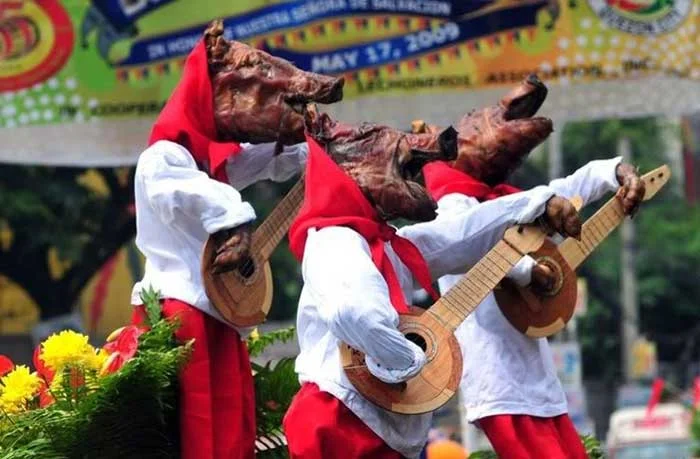[Culture] The Famous Lechon Parade in Balayan, Batangas
The town of Balayan on the western coast of the Province of Batangas is one of the province’s oldest; and history tells us that Balayan was among the first places in the province first explored by the Spanish conquistadores Martin de Goite and Juan de Salcedo in 15701.
During the Philippine Revolution of the late 19th century, many of the town’s prominent citizens were part of the Philippine intelligentsia that openly campaigned for independence; and its men were active fighters in the local Katipunan.
In recent times, however, Balayan’s claim to fame is more as a tourist destination, especially in the month of June, for its world famous festival and the annual “Parada ng Lechon2.” It has been included in various worldwide travelogues of various media.
 |
| Image credit: Hello Travel, "Parada ng Lechon." |
“A mix of Catholic Christianity from the missionary teachings of the Spanish and the pagan rituals of the pre-colonial peoples, the Roasted Pig Festival attracts thousands of tourists each year. Once dolled up, the crispy-skinned pigs are paraded around the village on motorized floats - much to the delight of the salivating, cheering crowds4.”
Mention was also made by Carl Parkes of the festival in his book “Southeast Asia Handbook.” His description noted that, while obviously a fun and well-anticipated event, it could also get out of hand: “...a bizarre Parada ng Lechon in Balayan, Batangas, south of Manila. This procession features dozens of freshly roasted and glazed pigs protected by raincoats to minimize baptism by beer, and barbed wire to discourage hungry spectators5.”
While the primary Catholic church in the Municipality of Balayan is dedicated to the Immaculate Conception, the feast of which is celebrated on the 8th of the month of December each year6, this celebration has been somewhat obscured by the more famous festival on the 24th of June with its equally famous parade.
The latter is traditionally recognized as the date of the birth of St. John the Baptist and is considered among the highest of liturgal feasts not only by the Catholic Church but also by the Anglican, Eastern Orthodox, and Lutheran churches7.
The festival being held on the feast of St. John the Baptist probably explains the water dousing associated with it. “Sometimes, the parade spectators get rowdy, bringing with them water and beer. When the parade passes, they start to hurl water at the carriers of the lechon and other spectators8.”
It has to be mentioned, however, that the practice of water dousing associated with the celebration of the feast of St. John the Baptist may be less a Christian tradition and may be traced back to spring festivals that likely originated in southern China and are celebrated across Southeast Asia9.”
The lechon parade itself is said to have originated “as an old thanksgiving custom of the working class in what-used-to-be the poor and depressed area of the Kanluran district of Balayan10.” Local families who believed that they received good fortune and blessings in the previous year would parade a lechon in the plaza in Balayan during the Spanish and American colonial eras.
The practice started to grow until it became institutionalized in 1959 when the Brotherhood of St. John the Baptist, composed of the elders of the Kanluran district of Balayan, began to manage the organization of the “parada ng lechon.”
2 “Parada ng lechon” literally translates into “parade of spit-roasted pigs.”
3 “The Time, The Place: 364 Days of Awesome Travel Experiences around the World,” by Sarah Woods, published 2009 in London, United Kingdom.
4 Ibid.
5 “Southeast Asia Handbook,” by Carl Parkes, published 1998 by Moon Publications, California, U.S.A.
6 “Balayan,” Wikipedia.
7 “Nativity of John the Bapist,” Wikipedia.
8 Translated into English from “Elementary Tagalog Workbook,” by Jiedson R. Domigpe and Nenita Pambid Domingo, published 2014 by Tuttle Publishing.
9 “Origins of the Buling-buling Tradition of Batangas and Elsewhere,” Batangas History, Culture and Folklore.
10 “Parada ng Lechon in Balayan, Batangas Philippines to Honor St. John the Baptist: An Ethnographic Study ,” by Maria Luisa V. Valdez, PhD, published 2014 in the Asia Pacific Journal of Multidisciplary Research, Volume 2, No 3.
